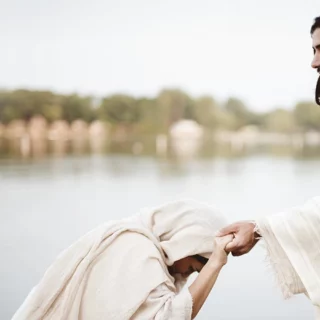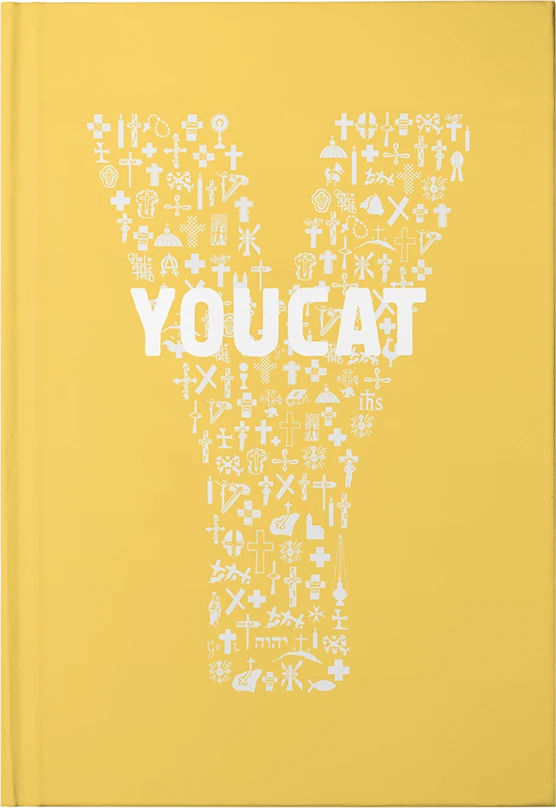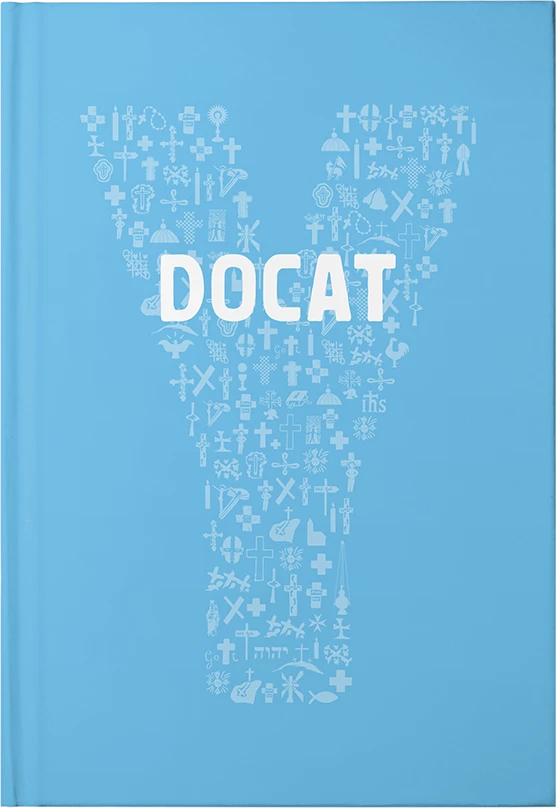

Credopedia
Catechism, Teaching and Dogma
The Catechism contains the official teaching of the Church. The teaching is based on the Bible and Tradition. Overview of the most important facts.
Definition
Catechism, Teaching and Dogma
The Catechism is an official manual of the Church, with which people who are willing to believe can get to know the binding faith of the Church. The term “Catechesis” (from Greek kat’echein = to lead up, to teach) has always denoted the introduction into the faith. That the Church has a Magisterium originates from a mandate given by Jesus to the Apostles (today: the Pope, the Bishops). With the help of the Holy Spirit, they are to teach and hold fast to “all those things … which are contained in the written word of God and in tradition” and to everything “to be believed as divinely revealed.” (I. Vatican Council). The Church can teach bindingly in matters of faith as well as morals, and for such teaching, she can demand from the faithful the “obedience of faith”. The word dogma (from the Greek dokein = to shine) is used to describe a doctrine of faith of the Church revealed by God before the death of the last apostle, which is regarded as irrevocable and demanded to be believed by the whole Church. A Catholic who publicly rejects a dogma of the Church is a heretic. A baptized person who rejects the entire faith of the Church is an apostate. Both are no longer in communion with the Church – you could say that they are excommunicated.
What does the Holy Bible say?
The belief in a binding faith (and not just in an opinion) is one of the first convictions of the early church. St. Paul says, “Now I would remind you, brothers, of the gospel I preached to you, which you received, in which you stand, and by which you are being saved, if you hold fast to the word I preached to you—unless you believed in vain” (1 Cor. 15:1-2). The authority of the apostles is derived from their eye- and ear-witness, but also from the word of Jesus: “The one who hears you hears me, and the one who rejects you rejects me, and the one who rejects me rejects him who sent me” (Luke 10:16). Paul greatly stressed the fact that “I delivered to you as of first importance what I also received.” (1 Cor. 15:3). In his letters you can frequently find phrases like “holding fast to the word of life” (Phil 2:16). Or: ” So then, brothers, stand firm and hold to the traditions that you were taught by us, either by our spoken word or by our letter.” (2 Thess. 2:15). In 2 Tim 4:3 he admonishes his readers to not fall away from faith: ” For the time is coming when people will not endure sound[1] teaching, but having itching ears they will accumulate for themselves teachers to suit their own passions”.
A short YOUCAT-Catechesis
Time to say goodbye to the Catechism?
The excitement caused by the Second Vatican Council (1962-1965) is hard to imagine today. The Catholic faith was still deeply rooted in Western society, although one could perceive a certain rigidness and division from which the church wished to break free. The promise of a new and hopeful beginning even impacted groups not closely associated with the church. I can remember how one of the leading French fashion designers crafted a collection of futuristic liturgical apparel that were exhibited by hip-swinging models. The supermodern pantsuits looked like they had been pulled straight out of Star Trek. Thanks Spock, but the Church did not end up buying into this new collection for itself.
I can’t help but think about this curious incident whenever I hear well-meaning Church leaders demanding that we must say goodbye to “outdated catechism truths,” as if they were old cloths that need to be thrown away now that they had been eaten up by moths.
It is true that the four parts of the catechism deal strictly with old material: the Creed is 1500 years old (and they refer back to even older sources), the Sacraments are 2000 years old, the Ten Commandments are approximately 3000 years old, and the Our Father, which structures the teaching of the Church in regards to prayer, has been around since Jesus, from the Church’s Year Zero, so to speak.
I don’t feel very comfortable at the thought of replacing time-tested truths through “modern insights.” The collection in vogue today is the outdated collection of tomorrow. I can only hope that the Church will not fall into the trap of believing we need to redefine our beliefs every five years.
A Pope from Poland and the Crisis of Faith
When a young and dynamic bishop from Poland was elected as Pope in the conclave in 1978, the whole Church marvelled at his agenda. Saint John Paul II’s gaze turned west, especially towards France and the Netherlands, which were detoriating instead of preparing for a new beginning. The Pope took decisive action. Almost from the first day of his pontificate, he commenced a project that he viewed as the fulfillment of all the reforms of the Second Vatican Council: the creation of a new catechism for the world. Its historic predecessor, the “Roman Catechism” of the Council of Trent, had lasted 400 years and fundamentally helped rebuild the Church following the Reformation.
This new catechism was intended to simiarily ensure that the essence of the Good News would not dissolve in the overwhelming complexity of modern society. In order to accomplish this, he appointed the most intelligent theologian of his time. The name of this person, who declined this offer, as he preferred his role as the bishop of Munich, was Cardinal Joseph Ratzinger. When the Prefect of the Congregation for the Doctrine of Faith finally took on this project, it caused a stir of protest. This stir developed into a storm in the western local parishes when Pope John Paul II approved the finished catechism in 1992 and proclaimed that it contained “the reliable dogmas of faith.” The new catechism was released in over 50 languages and was a million-copy bestseller. The self-appointed agents of reform in the Church viewed the publication of this book as an act of hierarchical supression. Did the Pope intend to lead the Church back into Medieval times?
Three arguments against the Catechism
Their first argument was as follows: A catechism can never be up to date because, as we know today, faith is a living thing that cannot be conserved in static pronouncements of dogma. Their second argument concerned the value placed upon the Holy Bible. Was this first and most important source of revelation to be further diluted? Were the people of God again to be forced to quench their thirst through the thin water of Church dogma instead of drinking from the clear fountain of the word of God? Their third argument concerned the perception of theology and extended well beyond merely criticizing the catechism. Did not the Church making use of the magisterium, dogma and the catechism therefore undermine scientifical theological work? Was the church really supposed to forever tell people what to do? Should it not utterly respect the decisions of the conscience of the people instead of assessing them through abstract norms?
Three responses to the arguments
The first argument is correct. If someone in the church were to tell their children, “You need to learn the catechism by heart to have faith,” one would have to say that this person is wrong. Faith must be passed on from one person to another, from heart to heart, in dialogical catechesis. But this does not mean that we cannot learn and present the content of faith in a reasonable way. YOUCAT 25 says, “Faith is not about empty words but about reality. In the Church, condensed formulas of faith developed over the course of time; with their help we can contemplate, express, learn, hand on, celebrate, and live out this reality. Without fixed forms, the content of the faith would dissipate. That is why the Church attaches great importance to definite sentences, the precise wording of which was usually achieved painstakingly, so as to protect the message of Christ from misunderstandings and falsifications. Furthermore, creeds are important when the Church’s faith has to be translated into different cultures while being preserved in its essentials, because a common faith is the foundation for the Church’s unity.”
The second argument is true as well — at least, half of it is. It is not the catechism which is the “norma normans non normata” of the Church, but the Holy Bible. It was about time that the Church helped the people to assess the riches of the Word of God, as the Council rightly demanded. But this does not therefore mean that the Church can only live referring to the Holy Scriptues as something that took place only in the past, as if God is not a living reality in our midst. This is why YOUCAT 12 says, “We find the true faith in Sacred Scripture and in the living Tradition of the Church. [76, 80–82, 85–87, 97, 100] The New Testament developed out of the faith of the Church. Scripture and Tradition belong together. Handing on the faith does not occur primarily through documents. In the early Church it was said that Sacred Scripture was “written on the heart of the Church rather than on parchment.” The disciples and apostles experienced their new life above all through a living fellowship with Jesus.”
All you need to know
In a way, you could say that the catechism is the book of the tradition of the Church. It always refers to the Holy Bible and says nothing that is not at least implicitly contained in the Bible; but the catechism also contains the deeper insights that the Church later gained and which matured into our common and binding faith. Without catechism, we would not know what a priest is, why we meet on Sundays for Holy Mass, why we fast during Lent, why we celebrate Easter, and a thousand other facts and rules of Christian life. To withhold the Catechism from Christians means removing them from the habitat in which a Christian can live and breathe.
The third argument is utterly wrong. The Church cannot exist without he magisterium and dogma. Those who try to undermine them is not practicing theology (the science of God), but is rather destroying its foundation. Theology is the science of faith. This means that theology does not produce faith, but is built upon faith. Theology enlightens, purifies and explains the faith that she receives from the Church, which also receives the “spirit of truth” (Jn 14:17) from God. YOUCAT 13 says, “The faithful as a whole cannot err in faith, because Jesus promised his disciples that he would send them the Spirit of truth and keep them in the truth (Jn 14:17). [80–82, 85–87, 92, 100]. Just as the disciples believed Jesus with their whole heart, a Christian can rely completely on the Church when he asks about the way to life. Since Jesus Christ himself gave his apostles the commission to teach, the Church has a teaching authority (the Magisterium) and must not remain silent. Although individual members of the Church can err and even make serious mistakes, the Church as a whole can never fall away from God’s truth. The Church carries through the ages a living truth that is greater than herself. We speak about a depositum fidei, a deposit of faith that is to be preserved. If such a truth is publicly disputed or distorted, the Church is called upon to clarify again “what has always and everywhere been believed by all” (St. Vincent of Lerins, d. 450).”
Unfortunately there are many theologians who downplay the catechism and mock the magisterium, as though they enjoy the state of not knowing. They are not doing the church any favors. They are confusing the faithful and contributing to the misconception that the contents of the faith are a battlefield of different opinions and, in the end, merely a collection of irrational claims. Someone who is expected to take up faith and built his house upon it has a right to know what he will get. Trusting in vague arguments would not lead me to become a Christian. I want to know what it is I am committing to.
What the Catechism does and does not do
Here is a helpful definition, every word of which you can take to heart: “The catechism is a book of the church, in which everything is coherently shown, enlightened through reason and vouched for by the Church, what you can reasonably hope, bindingly believe and consistently do to be a Christian.” The catechism contains well-chosen words — which, of course, are not made for eternity, as they can be replaced through different or better words. Even a dogma is only a phrase which separates a truth from something which is below it. With God’s help, one day we might be able to understand it even more clearly, more deeply and in a manner that we can explain it even more beautifully. But we cannot simply retreat behind these demarcations.
A Church that hides its dogmas in order to keep them alive in discourse will lose its standing. A Church without standing will produce Christians without standing, if it even interests anyone in the first place. In The Diary of a Country Priest, George Bernano describes what happens when someone can no longer grasp the concept of faith: “I have not lost faith. I think it is really a silly term to say ‘losing your faith’ as if you lose your wallet or your keys. You do not lose faith like that, but it will stop having any clear shape for your life. That is all.”
To read the catechism and to get in shape is a great strategy for Christians or those who want to become a Christian.

YOUCAT Digital
Discover our digital products, which will help you to grow in faith and become missionaries yourself.






